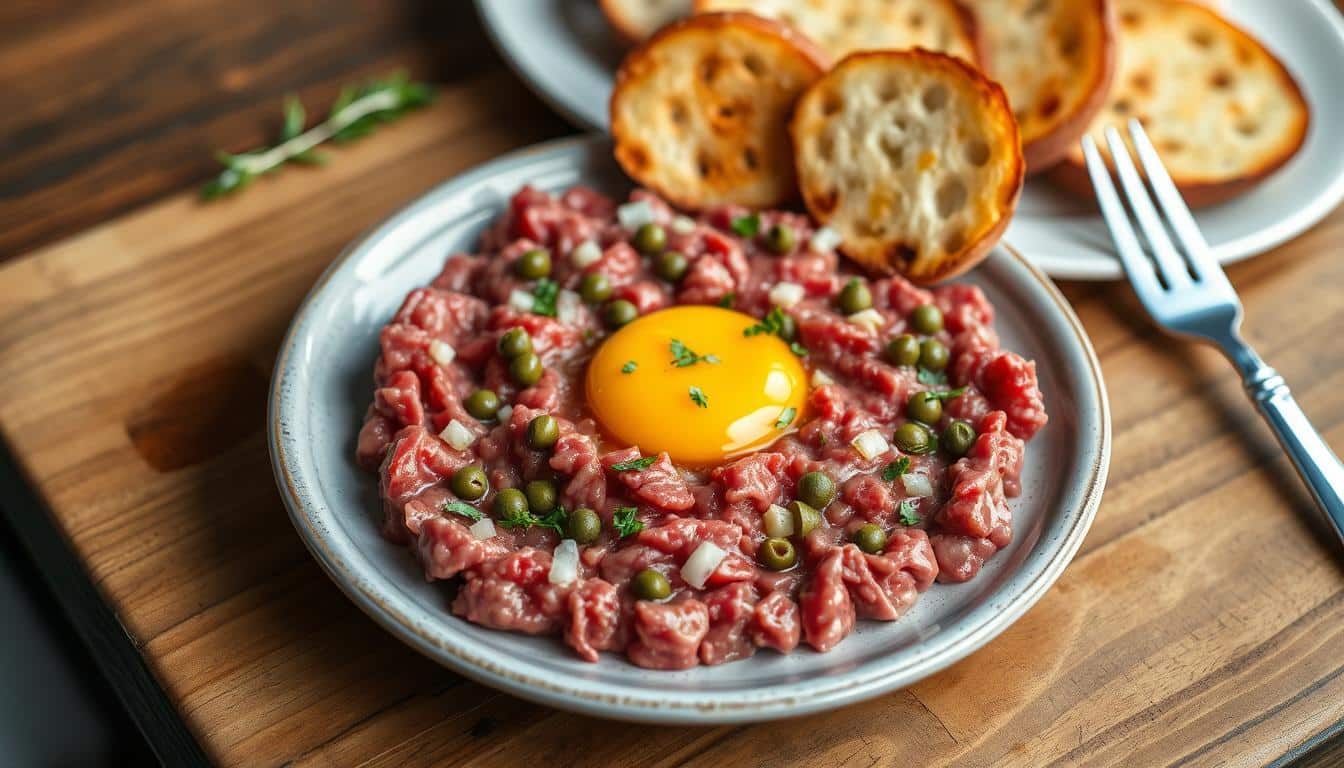Steak Tartare is a dish that excites food lovers everywhere. It’s made from raw beef tenderloin and offers a special dining experience. You’ll learn how to make this dish, from its history to how to prepare it today.
We’ll explore the world of Steak Tartare together. You’ll learn about choosing the best raw beef, keeping it safe, and seasoning it just right. This guide is for anyone who wants to enjoy and make this delicious dish.
The History and Origins of Steak Tartare
Steak tartare is a raw beef dish loved by many. It has a long history that spans centuries. This journey shows how it has stayed popular and changed over time.
Ancient Roots in Mongolian Cuisine
The story of steak tartare starts with the Mongol Empire. Warriors would put raw meat under their saddles. This made the meat tender and created a quick, protein-rich meal.
Evolution in European Fine Dining
When trade routes grew, raw beef dishes made their way to Europe. French chefs made the dish even better. They added seasonings and fresh egg yolk, making it a fancy treat.
Modern Interpretations and Global Influence
Now, steak tartare is enjoyed all over the world. Chefs try new things with raw beef and flavors. It’s found in fancy restaurants and cool bistros, showing off local tastes and new ideas.
“Steak tartare is not just a dish; it’s a journey through culinary history, from Mongolian steppes to Parisian bistros.”
The tale of steak tartare shows how food changes over time. It went from a simple meal for warriors to a fancy dish in fine dining. This shows how tradition and new ideas mix in cooking.
Understanding Raw Beef Safety and Selection
Steak tartare is all about the raw beef tenderloin. Choosing the right beef and following safety rules are key. Let’s look at how to pick and handle raw beef for your tartare.
Choosing the Right Cut of Beef
For steak tartare, use top-quality beef tenderloin. It’s tender, tasty, and perfect for eating raw. Look for meat that’s bright red and has little marbling for the best taste and texture.
Food Safety Guidelines
Food safety is very important with raw beef. Buy from trusted places and keep it cold until you use it. Always wash your hands and tools well before and after touching raw beef to avoid contamination.
- Use fresh beef within 1-2 days of purchase
- Keep raw beef separate from other foods
- Chill prepared tartare immediately if not serving right away
Working with Your Butcher
Having a good butcher can make your steak tartare better. A skilled butcher can help pick the best cuts and ensure you get the freshest, highest-quality beef.
| Aspect | Importance |
|---|---|
| Beef Quality | Essential for taste and safety |
| Proper Handling | Crucial for food safety |
| Butcher Expertise | Valuable for selection and advice |
Focus on quality beef, follow safety rules, and use your butcher’s advice. You’ll make a tasty and safe steak tartare at home.
Essential Ingredients for Classic Steak Tartare
The perfect steak tartare needs the right ingredients. Each part is key to its taste and feel. Let’s look at what makes this dish so special.
Premium Raw Beef Tenderloin
Steak tartare starts with top-notch raw beef tenderloin. It’s tender and tastes like butter. Choose grass-fed beef for better taste and health. Make sure to buy from a trusted butcher for freshness.
Traditional Seasonings and Aromatics
Seasonings make the beef taste even better. Shallots add a sweet onion taste. Capers add a salty kick. Dijon mustard brings depth and a bit of heat.
The Role of Fresh Egg Yolk
A fresh egg yolk is the star of steak tartare. It makes the dish rich and holds everything together. The yolk’s smoothness adds to the beef’s lean taste.
| Ingredient | Function | Quantity (per serving) |
|---|---|---|
| Raw beef tenderloin | Main protein | 4 oz |
| Egg yolk | Binder and richness | 1 |
| Shallots | Aromatic flavor | 1 tbsp, minced |
| Capers | Tangy, briny taste | 2 tsp, chopped |
| Dijon mustard | Depth and heat | 1 tsp |
Preparation Techniques and Kitchen Tools
Making perfect steak tartare needs care and the right tools. We’ll show you how to prepare this tasty dish with diced beef.
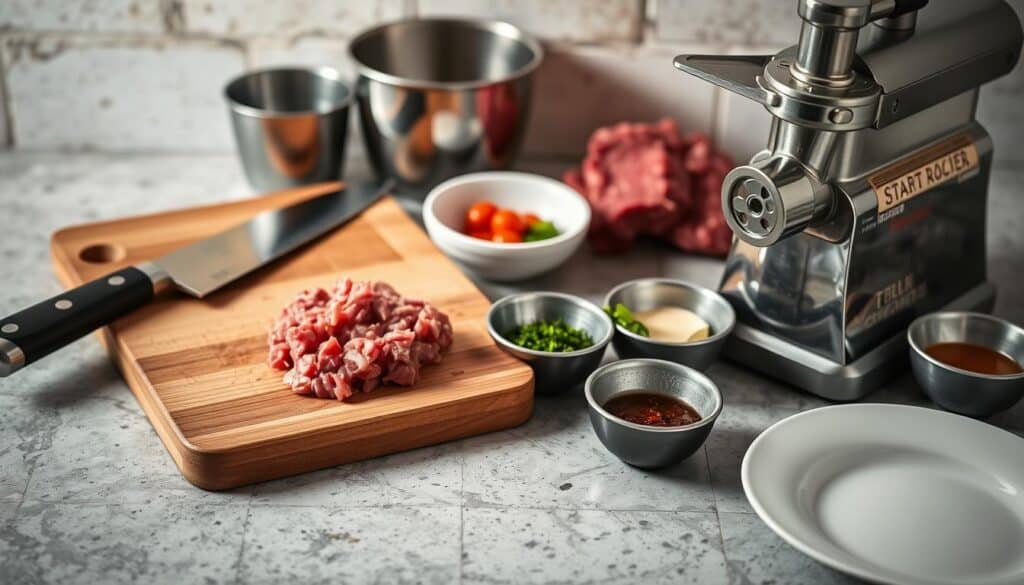
A sharp chef’s knife is key for the right texture. Choose a top-notch knife to cut the beef finely. This keeps the meat’s quality better than using a food processor or grinder.
Keeping the beef cold is important. Use a digital thermometer to keep it under 40°F. A cold cutting board helps keep the beef cool as you cut it.
- Chef’s knife for precise dicing
- Digital thermometer for temperature control
- Chilled cutting board to keep beef cold
- Mixing bowl for combining ingredients
- Small ramekins for serving
Hand-chopping the beef is best for texture. Cut the meat into thin strips, then dice it finely. This way, you control the beef’s size and texture.
“The key to exceptional steak tartare lies in the quality of your ingredients and the precision of your preparation techniques.”
With these tools and methods, you can make a tasty steak tartare. It will be as good as any fancy restaurant’s.
The Art of Hand-Chopping vs. Machine Grinding
Steak tartare can be made two ways: hand-chopping or machine grinding. Each method changes the dish’s texture. Let’s look at these techniques and their effects.
Traditional Hand-Cutting Method
Hand-chopping is the classic way to make steak tartare. It needs skill and patience. Chefs use sharp knives to cut the meat into tiny cubes.
Modern Grinding Approaches
Many places now use a meat grinder for speed. This machine makes the beef uniform. The texture is smoother than hand-chopped beef.
Some chefs like this method for its quickness and consistency.
Texture Considerations
The choice between hand-chopping and grinding changes the tartare’s texture. Hand-chopped beef has a varied mouthfeel. It has small chunks for a satisfying bite.
Ground beef is smoother and more uniform. Some people like this texture better.
| Method | Texture | Preparation Time | Skill Level |
|---|---|---|---|
| Hand-Chopping | Chunky, varied | Longer | High |
| Machine Grinding | Smooth, uniform | Shorter | Low |
The choice between hand-chopping and grinding depends on personal taste and restaurant style. Both methods can make great steak tartare.
Classic Steak Tartare Recipe
Let’s explore our favorite Steak Tartare recipe. It highlights the raw beef tenderloin’s pure flavors. It’s all about the quality of ingredients and how you prepare them.
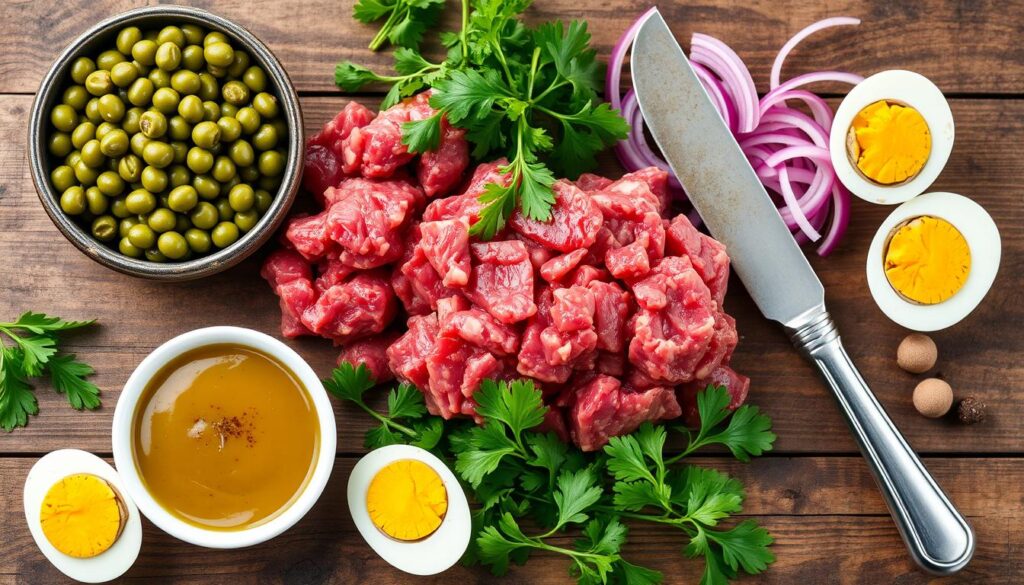
Begin with 8 ounces of top-notch raw beef tenderloin. Chop it finely by hand for the best texture. Mix the beef with 2 tablespoons of finely diced shallots, 2 teaspoons of capers, and 2 teaspoons of Dijon mustard.
Add a dash of Worcestershire sauce and a pinch of salt and pepper. This brings out the flavors.
Then, gently fold in 1 tablespoon of olive oil. Shape the mix into a round on a chilled plate. Make a small well and place a fresh egg yolk in it.
This egg yolk adds richness and helps bind the tartare. Serve it right away with toasted baguette slices or crisp lettuce leaves. Add some finely chopped chives or parsley for extra flavor.
“The beauty of Steak Tartare lies in its simplicity and the quality of its ingredients. It’s a dish that truly honors the beef.”
Remember, food safety is key when making Steak Tartare. Use the freshest ingredients and eat it right away for the best taste and safety.
Seasoning and Flavoring Variations
Steak tartare’s taste can change a lot with different seasonings. We’ll look at old and new ways to make this raw beef dish better.
Traditional French Style
Classic French steak tartare uses bold, simple flavors. Worcestershire sauce adds depth, and parsley brings freshness. Black pepper gives a gentle kick.
Dijon mustard and capers add tang and salt. These ingredients make the dish rich and tasty.
Contemporary Adaptations
Today’s chefs try new flavors. They might use soy sauce or sesame oil for an Asian twist. Or, they might add sun-dried tomatoes and olives for a Mediterranean taste.
Truffle oil or smoked salt can make it fancy. These ingredients add a unique flavor.
Regional Variations
Every place has its own way of making steak tartare. In Belgium, they add cognac and raw onions. Italian versions might have balsamic vinegar and Parmigiano-Reggiano.
In America, some chefs add hot sauce for a spicy touch. These changes make the dish special.
| Style | Key Ingredients | Flavor Profile |
|---|---|---|
| French | Worcestershire sauce, parsley, black pepper | Classic, savory |
| Asian-inspired | Soy sauce, sesame oil, ginger | Umami-rich, aromatic |
| Mediterranean | Sun-dried tomatoes, olives, basil | Tangy, herbaceous |
Trying new seasonings can turn steak tartare into a fun journey. The secret is to find the right mix of flavors. This way, the raw beef stays the star.
Proper Plating and Presentation
Steak tartare is a fancy dish that needs careful attention to how it looks. We think its look is as important as its taste. Let’s learn how to make it look great.
The first step is to pick the right plate. Go for a white or light-colored one to make the beef’s red color pop. A flat, wide plate is best for arranging the tartare nicely.
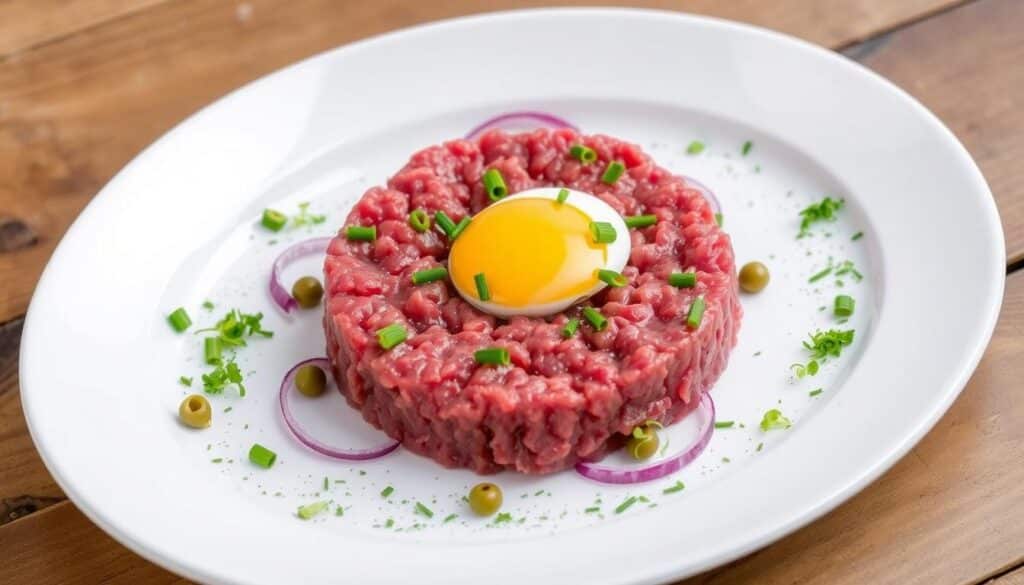
To make the tartare look amazing, shape it into a circle using a ring mold. Press it gently into the mold and then take it out. This makes the tartare look neat and round.
Garnishes are key for both taste and looks. Here are some good ones:
- Finely minced shallots
- Capers
- Chopped fresh herbs (parsley, chives)
- Microgreens
- Edible flowers
Put these garnishes around the tartare in small piles. It looks great and lets everyone pick their favorite flavors. To finish, place a golden egg yolk on top.
| Presentation Element | Purpose | Example |
|---|---|---|
| Plate Color | Contrast | White or light-colored |
| Tartare Shape | Uniformity | Circular using ring mold |
| Garnishes | Flavor and color | Shallots, capers, herbs |
| Egg Yolk | Richness and visual appeal | Centered on top |
The secret to a stunning steak tartare is balance and simplicity. Let the colors and textures of the ingredients shine. This makes a dish that’s as beautiful as it is delicious.
Wine and Beverage Pairings
The right drink can make your steak tartare experience better. We’ve picked out wine pairings and craft cocktails to go with this raw beef dish.
Red Wine Selections
Red wines go well with steak tartare. Light to medium-bodied reds with good acidity cut through the rich flavors. Try a Pinot Noir from Oregon or a Beaujolais from France for a perfect match.
White Wine Options
White wines can be great with steak tartare. Crisp, mineral-driven whites balance the meat’s richness. Consider a Chablis or an Alsatian Riesling for a refreshing contrast.
Craft Cocktail Pairings
Craft cocktails offer exciting pairings for adventurous diners. A classic Martini or a Bloody Mary can complement the flavors of steak tartare beautifully.
| Beverage Type | Recommended Pairing | Flavor Profile |
|---|---|---|
| Red Wine | Pinot Noir | Light, fruity, high acidity |
| White Wine | Chablis | Crisp, mineral, citrusy |
| Cocktail | Martini | Dry, herbal, clean finish |
Remember, the best wine pairing often comes down to personal preference. Don’t be afraid to experiment with different options to find your perfect match for steak tartare.
Restaurant vs. Home Preparation
Preparing steak tartare at home can be very rewarding. Restaurants have better equipment and skills. But, with the right techniques and ingredients, home cooks can make it just as good.
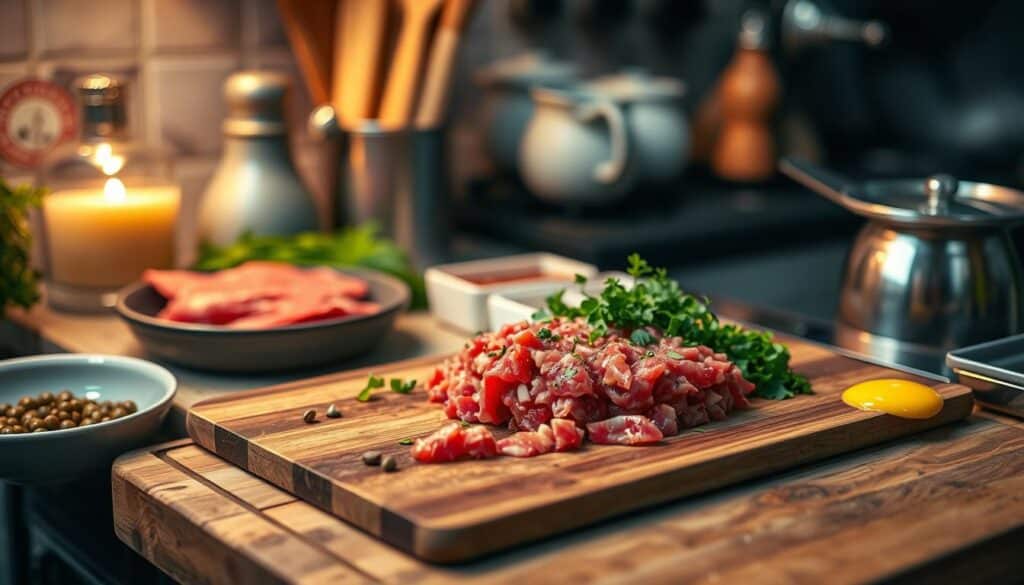
Professionals use special tools and top ingredients. They focus on perfect textures and flavors. At home, we can do the same by paying attention to texture and choosing the best ingredients.
To make your steak tartare better, get a sharp chef’s knife. This lets you control the texture, just like in restaurants. Choose fresh, quality beef from a trusted butcher for the best taste and safety.
| Aspect | Restaurant Preparation | Home Preparation |
|---|---|---|
| Equipment | Professional-grade tools | Standard kitchen equipment |
| Ingredient Quality | Top-tier, specialty sourced | High-quality, locally available |
| Preparation Time | Quick, efficient | Longer, more deliberate |
| Portion Control | Precise, standardized | Flexible, customizable |
Restaurants are great at being consistent and quick. But, making it at home lets you add your own touch. By learning basic cooking skills and using the best ingredients, you can make a steak tartare that’s as good as any restaurant’s.
Common Mistakes to Avoid
Making perfect steak tartare needs careful attention and quality control. We’ve found common mistakes that can ruin your dish’s safety and taste. Let’s look at these errors and how to avoid them.
Temperature Control Errors
Keeping the right temperature is key for safety. Always keep your beef cold, below 40°F (4°C). Don’t let it warm up too much. Use a cold plate or bowl when mixing to keep it fresh and stop bacteria from growing.
Seasoning Missteps
Getting the flavors right is an art. Don’t overdo it with too much seasoning. Start with a little and add more if needed. It’s better to add than to take away. Taste as you go to get the flavors just right.
Texture Problems
The texture of steak tartare is important. Don’t chop or grind the meat too much, or it will be too soft. Aim for a coarse texture that feels good in your mouth. If grinding, use the biggest die size to keep the meat’s texture.
- Use a sharp knife for hand-chopping to prevent tearing
- Chill your grinder attachments if using a machine
- Mix gently to avoid compressing the meat
By avoiding these mistakes, you’ll make your steak tartare as good as a restaurant’s. Remember, the more you practice, the better you’ll get at making this classic dish.
Conclusion
Steak Tartare is a true sign of culinary skill. It mixes raw beef with careful preparation. We’ve looked at its history, safety, and key ingredients.
Choosing the right cuts and chopping by hand are key. Each step makes the dish perfect.
The story of Steak Tartare shows how it has changed over time. It went from ancient Mongolian dishes to today’s versions. The right seasoning, plating, and pairings make it even better.
Enjoying Steak Tartare at home or in a restaurant is all about the details. It’s about respecting the tradition.
As we finish our guide, we invite you to try Steak Tartare. It’s all about using fresh, quality ingredients and careful prep. For more, check out other steak recipes.
Steak Tartare is more than food; it’s a journey of flavors and textures. With what you’ve learned, you’re set to make amazing dishes. Impress your friends and grow your taste buds.

